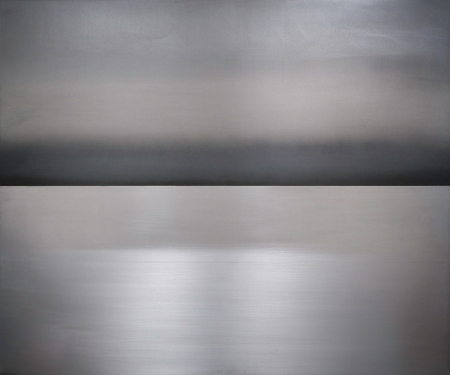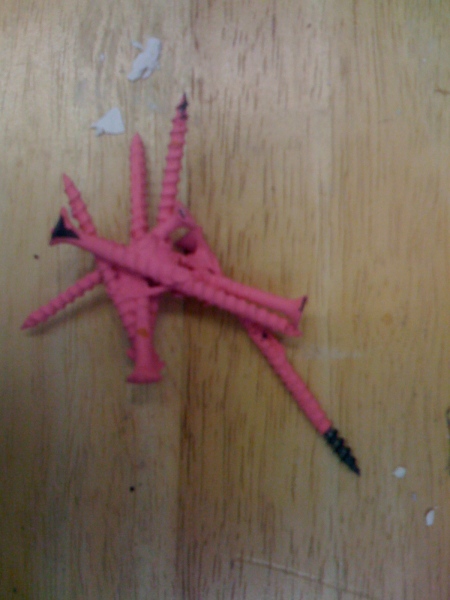Brochure Essay
Hypothetical Landscapes (Lattices and Grids of Abstraction)
By Greg Lindquist
What are the lattices and grids of pure abstraction, if not renderings and representations of a reduced order of nature?…There is no escaping nature through abstract representation, abstraction brings one closer to the physical structures within nature itself.
–Robert Smithson, “Nature and Abstraction” 1

Fraser Fir Farm, Western NC, Courtesy the Internet.
Driving recently through North Carolina’s mountains with a mathematician friend, 2 I observed breathtaking matrices of Fraser fir trees lining the hillside and pointed out to him how “geometric” they appeared. He laughingly replied, “Of course, they are—geometry is the study of all shapes, not just polygonal ones.” Yet, while in math this may be true, in painting discussing the geometric seems to carry associations of abstraction. In humanmade and natural forms, both visual and cerebral abstractions abound. Whether in the geometric residue of the grid or the often gestural, free-flowing vocabulary of organic forms, optic abstractions are informed by reality and, ultimately, nature. The visual relationship of the humanmade and natural ultimately is not diametrical, as we cannot often neatly differentiate where the physical world ends and human’s intervention begins. Smithson’s quote suggests that an abstract representation of nature not only is purer and more intrinsic than reality, but humans simply cannot make something unnatural: Anything manmade finds a structural or conceptual correlation in a natural form. 3
Many 20th century artists, while working in an abstract mode, found inspiration in or reference to the reality and specific elements of landscape. Paintings in Richard Diebenkorn’s Ocean Park series reference California’s suburban geography and sense of light.

Richard Diebenkorn, Ocean Park #54
In Mark Rothko’s canvases, brilliant color may be seen as light,

Mark Rothko, Installation view
while Milton Avery’s paintings hover between abstract divisions of space and representational landscape compositions.

Milton Avery, Offshore Island, 1958
Matta’s “inscapes,” composed from an iconography of consciousness, suggest deep space in an imagined, dream-like environment.

Matta, Annee
In addition, Sol LeWitt’s “Serial Project” sculptures demonstrate that while seeking new forms outside the Minimalist movement—something “neither geometric nor organic” as Donald Judd explained—his open and closed geometric forms neatly arranged on a grid refer to an ideal order of a city, not unlike the Renaissance Utopian ideals accompanying the “discovery” of a synthetic perspective. 4

Sol LeWitt, Serial Project, I (ABCD), Courtesy The Museum of Modern Art, NY, NY.
The eight contemporary artists in this exhibition similarly work in abstract modes while referring to natural or humanmade forms in the landscape. While these relationships are apparent in each of the artists’ work—some appearing more conceptually supposed than visually evident—they create a hypothetical proposition between abstraction and landscape. To order his or her pictorial reality, each artist utilizes an organizing structure—a lattice, grid, mesh or framework—from natural forms found in the landscape. The grid, with its associations to Modernism, repetition and rigidity, appears in these artists’ works in the form of reference, appropriation, or distortion. Also, lattices by definition are more expansive than what one may know as simply a trellis or gardening support for climbing plants.

Trellis in disrepair on W 13th St near Suzanne Stroebe's studio. Courtesy the Artist.
A lattice may also refer to an interlaced structure or pattern, such as a network of branches—as such plexus, it need not contain orthogonal axes like the grid.

Plexus in cactus skeletons from Arizonan desert. Courtesy the Author.
This web-like artery or arrangement also implies formations of atoms, ions or crystalline solids in physics and chemistry. In mathematics, a lattice denotes a partial ordered set, in which any subset has a supremum and an infinum.

The name "lattice" is suggested by the form of the Hasse diagram depicting it. Shown here is the lattice of partitions of a four-element set, ordered by the relation "is a refinement of". Courtesy Wikipedia.
Darina Karpov’s intricate drawings such as Untitled IV (sudden appearances into vanishing) are lattices of anthropomorphic shapes and plexuses of flora and pastoral elements in the landscape. Karpov’s amorphous compositions dissolve and coalesce in gestural rhythms on monochromatic grounds, recalling Matta’s fantastical topographies.

Darina Karpov, Untitled IV (sudden appearances into vanishing), 2008, Gouache and watercolor on paper, 12 1/8 x 9 in, Courtesy the Artist and Pierogi Gallery.
Matta’s dream-like paintings also find kindred spirit in Ati Maier’s hallucinogenic paintings, inspired by space exploration and travel in the American West. Unlike Matta’s murky atmosphere though, Maier’s scale expands through graphically flat layers. Maier’s choice of color such as in Level Out reflects a vibrating, electric boldness that recalls the virtual landscape encountered through the window of an Internet browser. The perspectival grid also frequently appears in Maier’s work in vanishing points, at once creating space in geometric counterpoint to her brand of fractured, gestural mesh and implying aerial photography.

Ati Maier, Level Out, 2008, Oil on canvas, 15.75 x 31.5 in, Courtesy the Artist and Pierogi Gallery
Malado Baldwin’s expressionistic paintings of interlocking bands of color call to mind the framework of organic abstraction in Milton Avery’s landscapes. Unlike Avery, Baldwin’s often fluorescent sensibility, such as in Everything Has Its Resonant Image, uses the CMYK palette characteristic of advertising. Like Maier, Baldwin suggests a natural world co-opted by the blaring chroma of graphic design.

Malado Baldwin, Everything has its resonant image, 2009, Oil on canvas, 12 x 16 in, Courtesy the Artist.
By contrast, Dustin Schuetz’s quietly glowing hard edge paintings, inspired by the structure and interior lights from within city skyscrapers in his studio view are redolent of Rothko’s color sensibilities.

Dustin Schuetz, Midnight Audit, 2009, Acrylic on canvas, 23.5 x 20 in, Courtesy the Artist.
While Schuetz’s structure may also recall LeWitt’s desire for an idealist notion of order, the subtly skewed grid in Midnight Audit functions in a similar way as Stephen Westfall’s earlier misaligned-grid paintings, where the Modernist vernacular of the grid has been distorted

Stephen Westfall, Yardbird, 2002, 48 x 60”, alkyd / oil on canvas, Courtesy Lennon/Weinberg, Inc.
Miya Ando’s hybrid painting-sculptures on steel, not only suggest Minimalist landscape, but also appear as metallic color field paintings, calling to mind Rothko and Albers. In Ando’s work, such as 04.09.51.38, the structure and stretcher of the cold-rolled steel painting is reciprocal to the grid. The lightness and reflection of the steel also contradicts its material weight.

Miya Ando 04.09.51.38, 2009, Steel, patina, pigment, lacquer, 51 x 38 in. Courtesy the Artist.
The wall relief sculptures of Don Gummer, Rebecca Smith and Suzanne Stroebe not only explore the relationship between painting and sculpture , but also the grid’s relationship to the humanmade and natural, architecture and flora. Don Gummer’s reliefs, often using metallic paint on wood, transpose the cultural constructs in architectural floor plans. In San Ambrogio over Santa Maria delle Grazie, Gummer overlays the plans of two Milanese Renaissance churches in which the semi-circular apse of Santa Maria interrupts the Sol LeWitt-like polygonal rhythm of the rows and columns created by the floor plan in San Ambrogio.

Don Gummer, San Ambrogio over Santa Maria delle Grazie, 2004, Oil on wood, 53 x 43 x10 in, Courtesy the artist.
Rebecca Smith’s wall sculptures, made of painted steel, suggest gestures of insects, maps of urban networks, and environmental/climate concerns. In Ross Ice Shelf, like Schuetz, Smith twists, bends and distorts the ordered matrices of the Modernist grid creating her signature lattice-like networks of line, yet her sculptures, like Gummer’s, in their titles refer to geographic realities. Smith’s eponymous title refers to one of many shrinking glaciers, which have become contemporary emblems of global warming.

Rebecca Smith, Ross Ice Shelf, Antarctica, 2006, Oil painted steel, 62 x 84 x 9 in, Courtesy the Artist.
Suzanne Stroebe’s wall reliefs and sculptures are composed of urban found objects.
 Suzanne Stroebe, May I, 2008, Wood, paint, found objects, Dimensions variable
Suzanne Stroebe, May I, 2008, Wood, paint, found objects, Dimensions variable
The grid is conceptually supposed as the upward reaching gravity in her freestanding sculptures that suggest the figure. Stroebe’s work such as May I exposes the innards of these fragments—broken matrices—like Gordon Matta-Clark, but unlike his contextual displacement through only dislocation, Stroebe lovingly reconfigures these carelessly discarded objects and through their reassembly discovers new contexts.

Gordon Matta-Clark, Various Installation Views of Bingo, Splitting Four Corners.
Like Gummer’s metallic-painted wood, Smith’s oil-painted steel and Ando’s metallic-painted steel, Stroebe’s sculptures embrace material contradiction. By painting metal screws pink, Stroebe emasculates a fastener stereotypically associated with the male-dominated construction trade with a color often considered feminine.

Suzanne Stroebe, Painted screws, Dimensions variable, 2009, Courtesy the Artist
This group exhibition refutes William Worringer’s claim that “the specific laws of art have, in principle, nothing to do with the aesthetics of natural beauty.” Of course, this was a quintessentially Modernist interpretation of abstraction, one detached from the trajectory of art history and a physical reality. In response, Smithson argued “Abstraction is a representation of nature devoid of ‘realism’ based on mental or conceptual reduction.” Smithson was interested in interstitial sites, often of construction and decay, locating the physical overlaps of the supposed natural and humanmade. He was concerned with dissolving semantic and semiotic distinctions of human and nature. This reinvestigation of signifier and signified is a process of discarding the name of what one sees in favor of a fuller awareness of its visual reality. It is in these intervening spaces of definition that these artists appropriate and contemporize Modernist forms, demonstrating the connectedness of abstraction and the natural world.
Acknowledgments: The author would like to thank Janet Kurnatowski, Matthew de Leon, the artists and Susan Swenson/Pierogi Gallery for the generous assistance and time. Thank you also to Linda Francis, John Hutchens, Susan Toplikar and Cary Levine for their input, proofreading and general guidance at various times. Thanks to Phong Bui for throwing the party!
Leave a comment